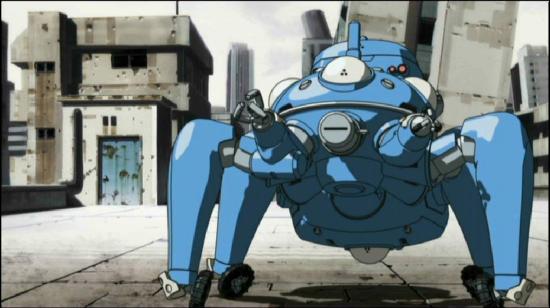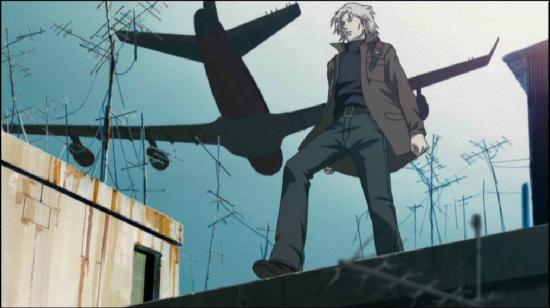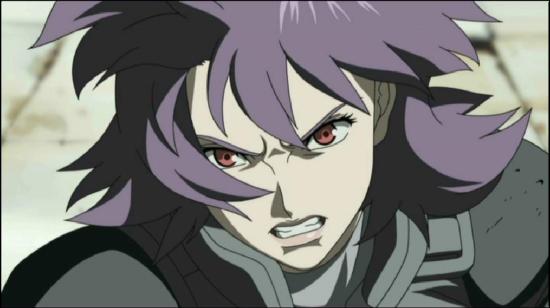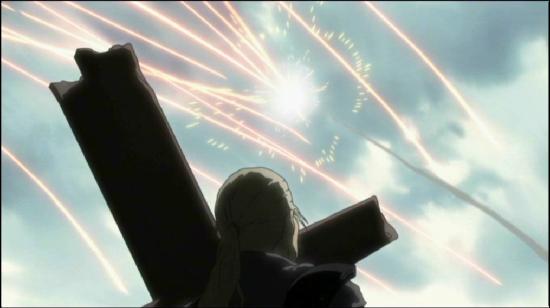Ghost In The Shell: Stand Alone Complex - Individual Eleven (UK) (DVD)
Introduction
Could this actually be it? Is this the point where I sketch in a faint pencil line underneath the Ghost In The Shell franchise? At this point in time, there is no new Ghost In The Shell product in the pipeline, and there is no indication that there will be anytime in the foreseeable future. Over the years, I've reviewed the lot, the two theatrical movies, the two television series, and the spin off Solid State Society feature. And just when I thought it was over, Manga announced the compilation movies. What I have just been watching is The Individual Eleven, the feature length movie of the 2nd Gig series. There will be the inevitable transition to Blu-Ray, but it looks like this is finally it for DVD. No more Ghost In The Shell. All in all, that adds up to something like 30 hours of entertainment, and let's face it, I'm knackered. I could do with a breather, but for a show that is still Manga Entertainment's flagship title, it would be good if it could go out on a high note.
The Individual Eleven certainly has its work cut out, as creating a feature film from 26 episodes of serial sci-fi action drama isn't easy. It means finding the heart of the story, paring down the episodes to the bare essential to make the story work, and then to edit it all together in some semblance of coherence. Fortunately the creators had a chance to practice with the first series, although I didn't find the Laughing Man movie an unqualified success. Turning the first series into a movie at times felt more like an exercise in editing than good storytelling, and the result, while a fine retelling of the first series for those who wanted a quick summary, didn't quite work for those wanting to enjoy a movie. It was a disjointed experience where the seams still showed, and ultimately offered little over the series other than brevity. The Individual Eleven is a different kettle of fish. The second series was much more complete an experience. The delineation between stand-alone and arc episodes was blurred, and the narrative flow played a greater part in the series. I originally opined that finding the relevant story elements would probably be a nightmare, but the resulting movie ought to be far more robust and consistent a viewing experience. Let's see if it worked.
Ghost In The Shell inhabits one of those strange new worlds we often hear tell of. Set in the not too distant future, the divisions between man and machine are blurring. AI is a reality, and life like androids do the menial jobs that humans used to. It isn't unusual for the average citizen to be enhanced in some way with implants or prosthetics. For some the enhancements are to such a degree that little of the original human remains. Major Motoko Kusanagi of Section 9 is one such person, who since the age of 6 has been equipped with a totally cybernetic body. The only biological component left is her brain. The differences between man and machine becomes ever more meaningless when machines can develop personality. It also opens up a whole new area of criminal activity, when cybernetically enhanced senses can be fooled by an enterprising hacker, or worse their brains themselves can be hacked into, subverting the innocent by reprogramming their 'ghosts'. In the light of such terrifying possibilities, a special unit is created to head off the threat of such cyber-crime. Section 9 led by Aramaki is at the forefront of combating the new cyber criminals.
Following the Laughing Man incident, Section 9 is quickly back to work when a spree of terrorist incidents take place, exacerbating the already precarious situation of Japan's refugee population. Since the war, more and more refugees have been finding work in Japan, helping with the rebuilding, but without the rights due to Japanese citizens. Meanwhile Japan's native populace has been growing increasingly restive with the influx, seeing vital resources and expenditure allocated to people who are no longer welcome. A group calling itself the Individual Eleven arise, looking to have the refugees removed, and they're not above violence to make their point. Section 9 quickly resolve a hostage crisis at the Chinese Embassy, but when a Defence Force helicopter AI goes rogue and takes up an ominous position in the refugee quarter, Section 9 finds itself in the uncomfortable position of taking orders from Kazundo Gohda of the Cabinet Intelligence Service. The Individual Eleven actions culminate in a mass televised suicide, of which there is only one survivor, a charismatic man named Hideo Kuze. When Kuze next surfaces, he's switched sides, and is leading the refugee cause and demanding autonomy for the refugee enclave at Dejima. What's worse is that the refugees are looking to become a nuclear power. Section 9 have their work cut out for them, when it appears that someone in the government is deliberately provoking the refugee crisis, Gohda has his own agenda, and the Major is distracted when she recognises Kuze.
Picture
Creating the Individual Eleven movie meant going back to the original episodes and finding the relevant footage, creating new animation where necessary, and giving the finished product a general spruce up to get it to theatrical standards. If you've seen the series, you should know what to expect in terms of animation, but you will never have seen the second series look this good before. The image on this disc is taken from a new HD master, and the picture is clear, sharp and crisp. The colours are more vivid, the detail is excellent, and on the whole the film looks more vibrant and stronger than the series. I did notice a little judder during a couple of pans, but it was hardly enough to get worked up about.
Sound
You have the choice of DD 5.1 and DD 2.0 English and Japanese. Making the film also meant reworking the dialogue to suit the new focus of the story, as well as making sure the music and the effects remained consistent. It's still the same immersive experience as before, with resounding action sequences, and a sublime score from Yoko Kanno. In Japan, the original cast came back to do the additional ADR for the film, but alas that wasn't the case for the English language version.
For the film, we get a new dub, from a new cast recorded at Ocean Studios in Canada. Don't get me wrong, as it's a good dub, with acceptable performances from all involved. But when it comes to Ghost In The Shell, Mary Elizabeth McGlynn is Motoko Kusanagi, Richard Epcar is Batou, Crispin Freeman is Togusa, and William Knight is Aramaki. The original cast own those roles, and hearing them recast just sounds wrong, even for an original language fanatic like me. What makes the recasting even more absurd is that in the US, the rights to the Innocence movie have passed from Dreamworks to Bandai, and for the Blu-ray release they are getting in the original Stand Alone Complex Cast to create an English dub for the film, a first in the US. The thing is that Manga already did this for UK region 2, the dub from that cast already exists. If Bandai can afford the expense of getting the original cast in to repeat the same work, what stopped the compilation movies from getting the same treatment?
Extras
The disc gets a nice set of holographic animated menus, perfectly suited to the movie. You'll also find trailers for Bleach, Karas, Vexille, GITS:SAC 2nd Gig, and the Naruto movie.
There is a new Tachikomatic short animation featuring the cute droids, as they investigate a murder mystery for 4 minutes.
The most substantial offering is the Stand Alone Complex Archives, which offers a 31-minute making of featurette. In the same vein as the Laughing Man featurettes, this is presented by the Japanese voice of Motoko, Atsuko Tanaka, and she interviews director Kenji Kamiyama, taking us on a journey to find out how this second movie was created, deciding what would go in, the differences and similarities to the 2nd Gig series, as well as the alterations in emphasis.
Conclusion
As before, I'll refrain from commenting on the story, as you can read my opinions in the series reviews of the 2nd Gig. But unlike the Laughing Man movie, The Individual Eleven succeeds as a stand-alone feature, as the creators have addressed the mistakes made on the earlier film, and have produced a much more cohesive and solid narrative. They've managed this by being far more brutal with the material, callously removing the excess weight and deliberately finding a story to tell from the 10 hours of footage that they had to work with. The obvious stand-alone episodes are gone, as well as pretty much the first two third of the series. The key elements that remain are the refugee problem, Gohda's machinations, and character arcs for the Major, Batou and Kuze. It also means that there is plenty of new dialogue, and I'm guessing that as much as 20% of the animation is new.
While the film may be called The Individual Eleven, they hardly get a look in, as they really just featured in the first half of the series. The terrorist attacks are used to build up the refugee stand-off, and episodes where Section 9 were actively involved in investigating the Individual Eleven have been wholly reedited and culled so as to make Section 9 observers not participants. This is to get the exposition out of the way as quickly as possible, as those earlier incidents are used as newsreel footage in a briefing delivered by Aramaki. The concept of the hub brain that plays a part in the dénouement is introduced right at the beginning of the film when the Major links with the Prime Minister to offer another burst of exposition.
We jump straight to the 2nd Gig's endgame after a quick bit of investigating. Having seen Kuze as part of the Individual Eleven, he turns up again as the champion of the refugees, and when it becomes apparent that he is trying to obtain plutonium to up the stakes in the standoff, Section 9 spring in to action. From them on, the film is a tense, fast-paced thriller as the pursuit of Kuze takes them from one dangerous situation to the next, and the tension keeps on building until the film's explosive climax. The film also makes more of the character relationships, and the Major's link to Kuze is explored deeper, as is her relationship to Batou. It gives the movie an emotional hook that makes it all the stronger, and it's certainly more effective than it was in the series. If there is one key element that gets short shrift, it's Gohda. In the series he had a gradual change from Machiavellian manipulator to series villain. Here it's more of a harsh jump.
The Laughing Man was little more than a summary of the first series. The Individual Eleven is a proper movie. By ditching most of the story, focusing on the final third, and playing up the more emotive aspects of the characterisations, it works exceedingly well. But to accomplish all that there has had to be a lot of changes. You'll find a lot of different dialogue, new scenes and new animation as well. But for newcomers to the franchise, they'll be able to watch it without too many questions on their mind, and existing fans of the series will be able to see the same events with a different perspective and an altered emphasis. The story may be the same, but the details are all different. Most importantly, after over 2½ hours, my butt remained un-numbed, and I hadn't looked at my watch once. Ghost In The Shell does indeed go out on a high note… For now.





Your Opinions and Comments
Be the first to post a comment!